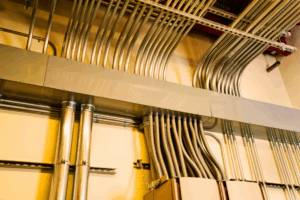How are low-voltage wiring methods in healthcare facilities addressed in the 2023 NEC?
518.4 Wiring Methods
Overview
| In modern healthcare facilities, the integration of low-voltage systems is indispensable for maintaining critical operations such as emergency communication, patient monitoring, data management, and fire safety. Correct installation and maintenance of these systems are vital for operational efficiency and safety. The 2023 NEC addresses this need by introducing a new subsection (B) in Section 518.4, which provides detailed guidelines for wiring methods specific to low-voltage systems. By outlining precise requirements for communications, signaling, data, and fire alarm systems, amongst other systems rated 120 volts or less, the updated code enhances clarity and ensures these essential systems function reliably, protecting both patients and healthcare workers. |  |
Applying the 2023 Code
Healthcare facilities utilize a variety of low-voltage systems to enable critical functions such as emergency communication, monitoring, data transfer, and fire safety. Reliable installation and maintenance of these systems are essential for smooth healthcare operations, accurate transmission of patient information, and effective implementation of safety protocols. Given their importance, proper wiring of these systems is paramount to prevent malfunctions and enhance the overall safety and operational efficiency of healthcare facilities.
Section 518.4 of previous NEC versions outlined specific requirements for the wiring methods used in healthcare facilities for systems like communications and fire alarms. The fixed wiring methods included metal raceways, flexible metal raceways, nonmetallic raceways encased in concrete, and various types of cables that either qualified as equipment grounding conductors or contained such conductors. Specific exceptions were made for audio signal processing equipment, communication systems, Class 2 and 3 circuits, and fire alarm circuits, which had their own set of regulations. Additionally, nonmetallic-sheathed cables and other nonmetallic conduits were permitted in non-fire-rated constructions, and certain nonmetallic tubing was allowed in spaces with a finish rating of at least 15 minutes, provided they were concealed within walls, floors, or ceilings. In the 2023 NEC, a new subsection (B) was added to address limited energy circuits and wiring systems often installed in assembly occupancies. This new subsection, derived from reworking the exception in the previous 518.4(A), mandates specific fixed wiring methods for various systems. It covers communications, signaling systems, data systems, fire alarm systems, and systems less than 120 volts, specifying the appropriate articles and parts of the NEC to refer to for each system type. This change provides clearer guidance and promotes the safe installation of low-voltage systems critical to the operation and safety of healthcare facilities.
What’s New for the 2023 NEC?
The comparison of 2020 NEC and 2023 NEC in terms of Section 518.4, is given in the Table below.
| 2020 NEC | 2023 NEC |
| 518.4 Wiring Methods
(A) General The fixed wiring methods shall be metal raceways, flexible metal raceways, nonmetallic raceways encased in not less than 50 mm (2 in.) of concrete, Type MI, MC, or AC cable. The wiring method shall itself qualify as an equipment grounding conductor according to 250.118 or shall contain an equipment grounding conductor sized in accordance with Table 250.122. Exception: Fixed wiring methods shall be as provided in the following:
(B) Nonrated Construction In addition to the wiring methods of 518.4(A), nonmetallic-sheathed cable, electrical nonmetallic tubing, and rigid nonmetallic conduit shall be permitted to be installed in those buildings or portions thereof that are not required to be of fire-rated construction by the applicable building code. (C) Spaces With Finish Rating Electrical nonmetallic tubing and rigid nonmetallic conduit shall be permitted to be installed in club rooms, conference and meeting rooms in hotels or motels, courtrooms, dining facilities, restaurants, mortuary chapels, museums, libraries, and places of religious worship where the following apply:
Electrical nonmetallic tubing and rigid nonmetallic conduit are not recognized for use in other space used for environmental air in accordance with 300.22(C). |
518.4 Wiring Methods
(A) General The wiring method shall qualify as an equipment grounding conductor in accordance with 250.118 or shall contain an equipment grounding conductor sized in accordance with Table 250.122, and shall be any of the following:
(B) Communications, Signaling Systems, Data Systems, Fire Alarm Systems, and Systems Less Than 120 Volts, Nominal Fixed wiring methods for specific installations shall be as follows:
(C) Nonrated Construction In addition to the wiring methods permitted by 518.4(A), nonmetallic-sheathed cable, electrical nonmetallic tubing, and rigid nonmetallic conduit shall be permitted to be installed in those buildings or portions of those buildings that are not required to be of fire-rated construction by the applicable building code. (D) Spaces With Finish Rating Electrical nonmetallic tubing and rigid nonmetallic conduit shall be permitted to be installed in club rooms, conference and meeting rooms in hotels or motels, courtrooms, dining facilities, restaurants, mortuary chapels, museums, libraries, and places of religious worship where the following apply:
Electrical nonmetallic tubing and rigid nonmetallic conduit are not recognized for use in other space used for environmental air in accordance with 300.22(C). |
